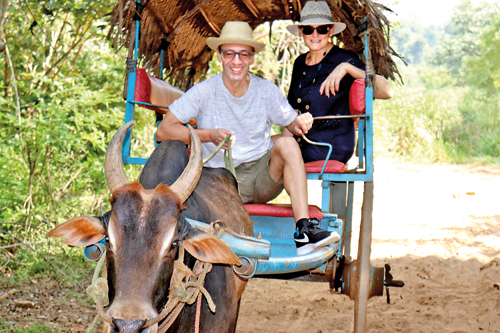Reviving tourism in Sri Lanka

Tourists enjoying a ride on a bullock cart
The tourism industry is, by far, the worst affected industry by the COVID-19 pandemic; not just in Sri Lanka, but across the world. In 2018, the last ‘good year’ for tourism, Sri Lanka generated US$4.5 billion as forex earnings, a contribution of 5 percent to the country’s GDP, thanks to 2.3 million foreign arrivals. Taking into account both the direct and indirect employment generated by the industry, together with their total number of dependents, it is estimated that the livelihoods of 2.5 to 3 million people, nearly 15 percent of Sri Lanka’s population, are dependent on tourism.
Unfortunately, the 2019 Easter Sunday bombings crippled the industry and as it was slowly raising its head from the ashes, in late 2019 and early 2020, the pandemic hit, bringing it all to a grinding halt. Whilst hotels, both large and small, suffered tremendously due to the lockdowns, the lesser players in the industry – Tourist Guides, Safari Jeep drivers, Chauffeur Guides et al – lost their major source of income, overnight.
Loss of livelihoods
Travel agents engaged in inbound tour operations, otherwise known as Destination Management Companies (DMCs) suffered a similar fate. A majority of the smaller companies was forced to shut down. The number of registered DMCs that once stood at over 2,400, in early 2019, has now reduced to a mere 600+ agencies. The DMC community in Sri Lanka had provided direct employment to over 11,830 people and nearly 2/3rds of this number, and their dependents, have lost their livelihoods.
Given the statistics, it is clear that it is vitally important that this industry is revived as soon as is possible. Given the current depleted foreign reserves of the country, tourism is possibly the only industry that could bring in this much-needed foreign exchange in the short term. Research conducted in our generating markets, over the last year, has shown that there is pent up demand for overseas travel, which will assure a boost to the industry, no sooner it is permitted to re-start.
Economic importance of opening up
It is with this information in hand that the Sri Lanka Tourism Development Authority (SLTDA), together with its industry partners, lobbied and convinced the authorities of the importance of opening up the island for tourism. A very detailed set of protocols was painstakingly formulated, covering every possible angle, and was put in place to ensure that there would be no spread of the virus from the tourists to the local population, and vice versa. In spite of this, the initiative was met with baseless criticisms that spread like wildfire, both on mainstream and social media.
As per SLTDA statistics, since the opening of the country’s borders, the country welcomed 15,487 tourists from December 2020 up to May 18, 2021. This number included the Eastern European tourists that came in, on a pilot project, in late December 2020. With two French Naval Vessels calling in Colombo from June 7 to 11, on an inter Government agreement, 640 sailors toured the island in a bio bubble as tourists. This brought up the total to 16,127 tourists. Of this 16,127, only 170 tested positive, for COVID-19, a percentage of just 1.04 percent. No deaths were reported and all tourists that had tested positive recovered and returned safely to their country of residence. In addition, there is no evidence to show that any local was infected by a visiting tourist. This is proof that the protocols put in place and travel, within the Bio Bubble concept, worked, and still works.
The baseless criticism, both on mainstream and social media, has created a very negative impression of tourism. This is very sad as the industry strives to raise its head, once more, and support the almost 15 percent of the population that has lost its major source of income and have been living in a desperate state, on zero income, from April 2020. It is also detrimental to Sri Lanka’s economy, which already has very low foreign reserves, to the extent that it is being downgraded by reputed rating agencies, decreasing our chances of much needed foreign investment. When revived, tourism will be the one industry which would recover in the very short term and bring in much needed foreign exchange to help stabilise the economy. Unlike other foreign exchange (FE) earner industries, 95 percent of tourism FE earnings are retained locally as opposed to being repatriated for raw materials, et al, which happens in most other industries.
Let the truth be told
The current negative impression of tourism, as portrayed in the mainstream and social media, will have far reaching effects including that of ruining its most valued, and unique, selling point – the Smiling Faces and Warm Hospitality – that Sri Lanka extends to any visitor, by its wonderful people. Why destroy an industry that is of such great importance to this country, to its economy, and to the lives of the almost 3 million citizens whose lives depend on it?
While sensationalism may be appealing to the majority, and the circulation and interpretation of partial facts may titillate those intent on mischief, the harm that it does to the country and its people may have negative repercussions on the prosperity of both, for years to come. Criticism is important, especially if it is based on fact, and contributes to the adoption of better, safer and more efficient practices. That based on half-truth and fallacy helps none, and is detrimental to the recovery of the country from its current, desperate economic plight. Let the truth prevail.


